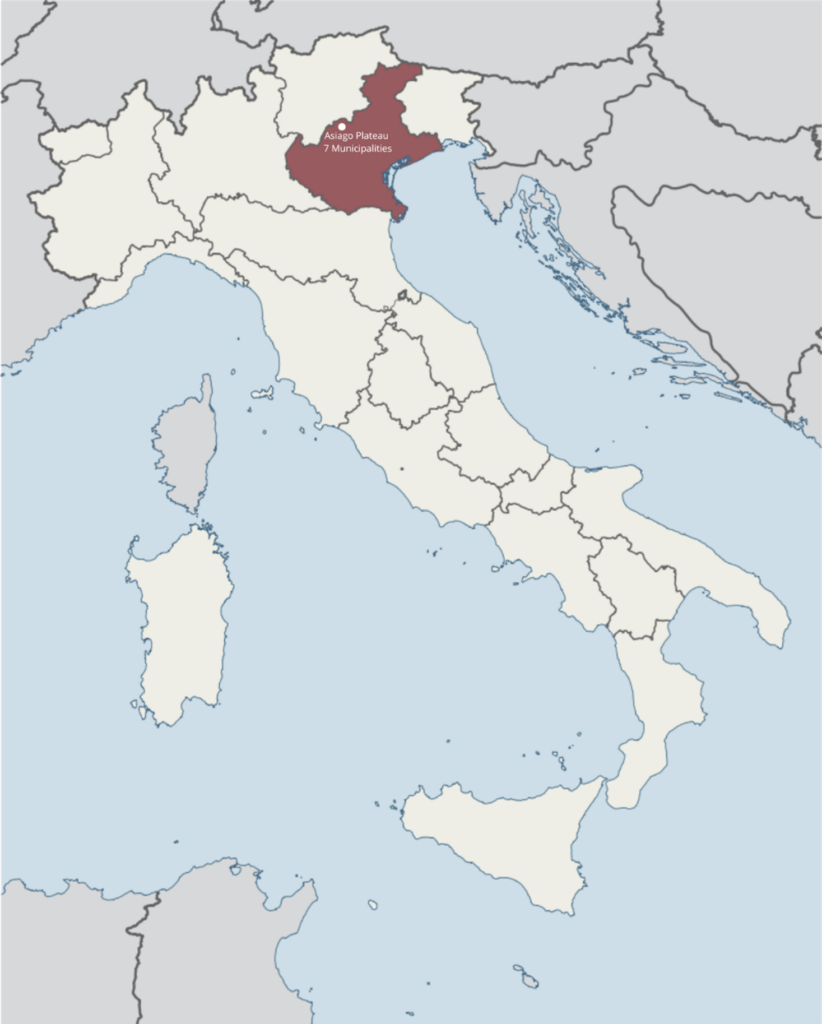Population: 4,9 million
GDP per capita: EUR 31,4 thousand
Unemployment: 5.8%
Enterprises: 428 thousand
Energy consumption from renewable sources: 17.3%
Veneto, the eighth largest region in Italy, spans seven provinces and boasts diverse landscapes. With areas like the Alpine zone, hills, lower plain, and coastal territory, it covers 18364 sq km. Nearly 29% of Veneto is mountainous, 57% is the Po Valley, and the remaining 14% comprises low hills. The plain itself is subdivided into the higher plain and lower plain, which rich in water sources, is vital for agriculture and the most populated. Several rivers are flowing through the region as well.


Population: 20 209 inhabitants
Unemployment: 6%
Enterprises: 2 809
The Seven Municipalities Plateau, in northern Vicenza, in Veneto Region, is a 350 km² mountainous area rich in forests, pastures, and karst landscapes. Its peaks rise above 2,000 meters and host typical Alpine flora and fauna. It includes seven municipalities, including Asiago, united by a strong historical and cultural identity. The area was a key battleground during World War I and is now a renowned destination for nature, outdoor sports, and historical tourism.
The Plateau of the Seven Municipalities has a resident population of 20 209, with Asiago being the most populated municipality. Between 2015 and 2021, the area experienced a population decline of 4%, reflecting a broader trend of depopulation affecting many Alpine and rural regions.
The economy of the Plateau of the Seven Municipalities is mainly based on tourism, with strong winter and summer attendance, and on the production of cheeses, including the famous Asiago DOP. The agricultural and livestock sector is important, with alpine pastures and malghe, as well as stone extraction. Additionally, craftsmanship and wood processing are highly developed.

The Foundation is a leading advocate for pilgrimage routes in Italy, promoting slow and sustainable tourism experiences in Italy and abroad. Over the past decade, it has been a key proponent of the Via Romea Strata, an international pilgrimage route crossing 7 countries from the Baltic Sea to Rome. The Foundation not only maintains the route, but through its pan-European network, also provides comprehensive trip services, including accommodation, guides, and information on historical, artistic, cultural, and religious heritage along the path. With expertise in route development, heritage preservation, network creation, and sustainable tourism promotion, the Foundation views the Romea Strata as a valuable resource for experimenting with innovative research practices and successful territory enhancement models.

The Designated Territorial Area (ATD) of LAG Montagna Vicentina covers a predominantly mountainous region in the northern part of the Province of Vicenza, Veneto Region, and includes 39 municipalities within an area of 1 271 square kilometers, representing 47.13% of the provincial territory.
The resident population over the last three years, has experienced a slight decline, from 148 374 inhabitants at the beginning of 2020 to 146 649 at the beginning of 2022. This represents a minor decrease, though overall depopulation from 2015 to today has been -2.98%.
The LAG on the Asiago Plateau 7 Municipalities, in collaboration with SIMES leader Fondazione Homo Viator, aims to combat depopulation and foster local sustainable development through innovative tools and initiatives, with a particular focus on Slow Tourism.The engagement of a diverse pool of private and public stakeholders, already overseen by the LAG, ensures local community ownership throughout the process.

This project has received funding from the European Union’s Horizon Europe research and innovation program under grant agreement no 101060876. UK participants in Horizon Europe Project RURALITIES are supported by UKRI grant numbers: 10051963 The Highlands and Islands Transport Partnership and 10050988 Earthwatch Europe.
